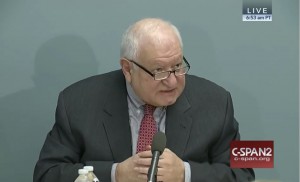
Demetrios Papademetriou, European president of the Migration Policy Institute, speaks at the institute Wednesday about solutions to the refugee crisis in Europe. (Image courtesy of C-SPAN)
WASHINGTON- The trickle of Syrian refugees into the United States has gone smoothly so far, making the country the best equipped to lead Europe on the refugee crisis, according to migration experts.
European countries are divided on how to handle refugees reaching their borders, a challenge the U.S. already has experienced, said Demetrios Papademetriou, the European president of the Migration Policy Institute, a think tank specializing in immigration issues.
“These things happen best when the U.S. leads,” Papademetriou, a Greek national, said.
The U.S. has the advantage of being able to vet refugees before they come into the country. In Europe, refugees can more easily enter countries without being officially accepted, which is hurting the process, he said.
About 85,000 refugees from all over the world will come to the U.S. this year, including the 10,000 Syrian refugees authorized by President Barack Obama, according to Eskinder Negash, a senior vice president of the U.S. Committee for Refugees and Immigrants. That compares to the annual average of about 70,000 refugees, he said.
About 900 Syrian refugees have entered the U.S. since October, according to the State Department.
“We have the moral authority to lead (on) how refugees should be treated given our commitment and what we have done,” Negash said.
The committee for refugees and immigrants is one of nine organizations that settle refugees in the U.S. It starts with picking them up at the airport and includes helping them find housing, jobs and clothing. This integration process of providing refugees education and jobs is one of the major challenges for European countries, Papademetriou said.
“For other countries it’s probably a little bit challenging,” Negash said in a phone interview. “We have mastered the process of processing refugees.”
Even though 31 governors have proposed a ban on Syrian refugees entering their states, Negash said the acceptance and settling of the Syrians has been smooth. Political opposition to Syrian refugees and fears of terrorism haven’t prevented resettlement organizations from helping refugees find homes and jobs, he said.
“A lot of governors know that this (immigration) is a federal program,” Negash said. His organization has offices in nearly every state, regardless of the governor’s stance on immigration.
Most Syrian refugees who came to the U.S. between 2009 and 2013 live in California, according to a migration institute report. New York, Illinois and New Jersey were the next biggest destinations.
In Europe, many refugees come in through Greece, taking trains to Athens from outside the Schengen zone and moving into other countries like Germany and Sweden, he said.
“What drives the crisis in Europe is the chaotic way people are coming in, not just the numbers,” Papademetriou said.
Migrants coming into Europe and the U.S. expect safety in their new homes, he said.
“The expectations are that they will be welcomed, that there will be opportunity for them,” he said.


